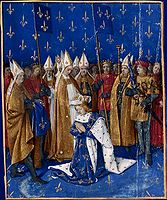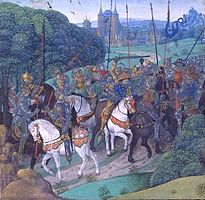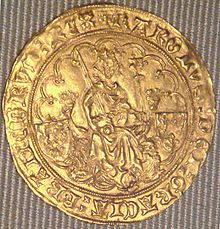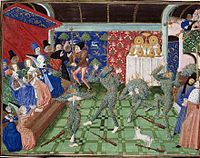- Charles VI of France
-
Charles VI the Mad 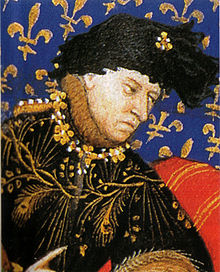
Charles VI of France by the painter
known as the Master of Boucicaut (1412).King of France Reign 16 September 1380 – 21 October 1422 Coronation 4 November 1380 Predecessor Charles V Successor Charles VII Spouse Isabeau of Bavaria Issue Isabella, Queen of England
Joan, Duchess of Brittany
Louis, Dauphin of Viennois
John, Dauphin of Viennois
Marie, Prioress of Poissy
Michelle, Duchess of Burgundy
Catherine, Queen of England
Charles VII of FranceFather Charles V of France Mother Joan of Bourbon Born 3 December 1368
Paris, FranceDied 21 October 1422 (aged 53)
Paris, FranceBurial Saint Denis Basilica Charles VI (3 December 1368 – 21 October 1422), called the Beloved (French: le Bien-Aimé) and the Mad (French: le Fol or le Fou), was the King of France from 1380 to 1422, as a member of the House of Valois. His bouts with madness, which seem to have begun in 1392, led to quarrels among the French royal family, which were exploited by the neighbouring powers of England and Burgundy. By the end of his reign much of France was under foreign occupation.
Contents
Early life
He was born in Paris, the son of King Charles V and Joan of Bourbon. At the age of eleven, in 1380, he was crowned King of France in the cathedral at Reims. He married Isabeau of Bavaria in 1385. Until he took complete charge as king in 1388, France was ruled primarily by his uncle, Philip the Bold, Duke of Burgundy. During that time, the power of the royal administration and the authority to tax was reestablished, following the tax revolt known as the Harelle, after his father had repealed the taxes on his deathbed.
Charles VI was known both as Charles the Beloved and later as Charles the Mad, since, beginning in his mid-twenties, he experienced bouts of psychosis. These fits of madness would recur for the rest of his life.
Madness
Charles's first known episode occurred in 1392 when his friend and advisor, Olivier de Clisson, was the victim of an attempted murder. Although Clisson survived, Charles was determined to punish the would-be assassin, Pierre de Craon, who had taken refuge in Brittany.
Contemporaries said Charles appeared to be in a "fever" to begin the campaign and appeared disconnected in his speech. Charles set off with an army on 1 July 1392. The progress of the army was slow, nearly driving Charles into a frenzy of impatience.
As the king and his escort were travelling through a forest on a hot August morning, a barefoot leper dressed in rags rushed up to the King's horse and grabbed his bridle. "Ride no further, noble King!" he yelled. "Turn back! You are betrayed!" The king's escorts beat the man back but did not arrest him, and he followed the procession for a half-hour, repeating his cries.
The company emerged from the forest at noon. A page who was drowsy from the sun dropped the king's lance, which clanged loudly against a steel helmet carried by another page. Charles shuddered, drew his sword and yelled "Forward against the traitors! They wish to deliver me to the enemy!" The king spurred his horse and began swinging his sword at his companions, fighting until one of his chamberlains and a group of soldiers were able to grab him from his mount and lay him on the ground. He lay still and did not react, but fell into a coma. The king had killed a knight called "The Bastard of Polignac", and several other men, the number of which varies among contemporary chronicles.
The king continued to suffer from periods of mental illness throughout his life. During one attack in 1393 Charles could not remember his name and did not know he was king. When his wife came to visit, he asked his servants who she was and ordered them to take care of what she required so that she would leave him alone.[1] During an episode in 1395–1396 he claimed that his name was George and that his coat of arms was a lion with a sword thrust through it.[2] At this time, he recognized all the officers of his household but did not know his wife or his children. Sometimes he ran wildly through the corridors of his Parisian residence, the Hôtel Saint-Pol, and to keep him inside, the entrances were walled up. In 1405, he refused to bathe or change his clothes for five months.[3] His later psychotic episodes were not described in detail - probably because of the similarity of his behavior and delusions. Pope Pius II, who was born in the middle of the reign of Charles VI, wrote in his Commentaries that there were times when Charles thought that he was made of glass, and this caused him to protect himself in various ways so that he would not break.[4] This condition has come to be known as glass delusion.
The Bal des Ardents
On 29 January 1393, at the behest of the king, a grand party was organized to celebrate the wedding of one of the queen's ladies-in-waiting at the Hotel de Saint Pol. At the suggestion of a Norman Squire, Huguet de Guisay, the King and four other lords[5] dressed up as wild men and danced about chained to one another. They were "in costumes of linen cloth sewn onto their bodies and soaked in resinous wax or pitch to hold a covering of frazzled hemp, so that they appeared shaggy & hairy from head to foot".[6] At the suggestion of one of the "wild men," Yvain de Foix, the king commanded – in view of the obvious danger of fire – that the torch-bearers were to stand at the side of the room. Nonetheless, the King's brother, Louis of Valois, Duke of Orléans, who had arrived late, approached with a lighted torch in order to discover the identity of the masqueraders, and he accidentally set one of them on fire. Alternatively, it may have been a plot to kill the mentally deficient king. In any case, there was panic as the fire spread. The Duchess of Berry, to save a dancer who had come near her to intrigue and tease her, threw the train of her gown over him, and it was soon revealed to her that the life she had saved was the king's.[7] Several Knights who tried to put out the flames were severely burned on their hands. Four of the wild men perished: Sir Charles de Poiters son of the Count of Valentinois, Huguet de Guisay, Yvain de Foix and the Count of Joigny. Another, Jean son of the Lord de Nantouillet, saved himself by jumping into a dishwater tub.[8] This incident became known as the Bal des Ardents (the "Ball of the Burning Men").
Struggles for power
With the King mad, his uncles Philip the Bold, Duke of Burgundy, and John, Duke of Berry, took control and dismissed Charles's advisers and various officials he had appointed. Another contender for power was the King's brother, Louis I de Valois, Duke of Orléans. This was to be the start of a series of major feuds among the princes of royal blood which would cause much chaos and conflict in France even beyond Charles's reign.
French Monarchy
Capetian Dynasty
(House of Valois)Philip VI Children John II John II Children Charles V Louis I of Anjou John, Duke of Berry Philip the Bold Charles V Children Charles VI Louis, Duke of Orléans Charles VI Children Isabella of Valois Michelle of Valois Catherine of Valois Charles VII Charles VII Children Louis XI Charles, Duke of Berry Louis XI Children Charles VIII Charles VIII The first major feud was between Philip the Bold and Louis, duke of Orléans who both tried to fill the power vacuum left by the King's condition. Philip's death in April 1404 did not bring an end to Louis's problems. John the Fearless, the new Duke of Burgundy took over and the feud escalated. In 1407, the Duke of Orléans was murdered in the streets of Paris. John did not deny responsibility, claiming that Louis was a tyrant who squandered money.
Louis's son, Charles, new Duke of Orléans, turned to his father-in-law, Bernard VII, Count of Armagnac, for support. This resulted in the Armagnac-Burgundian Civil War.
Charles VI's secretary, Pierre Salmon, spent much time in discussions with the king while he was suffering from his intermittent but incapacitating psychosis. In an effort to find a cure for the king's illness, stabilize the turbulent political situation, and secure his own future, Salmon supervised the production of two distinct versions of the beautifully illuminated guidebooks to good kingship known as Pierre Salmon's Dialogues.
The English invasion
Charles VI's reign was marked by the continuing conflict with the English known as the Hundred Years' War. An early attempt at peace occurred in 1396 when Charles's daughter, the almost seven-year-old Isabella of Valois, married the 29-year-old Richard II of England.
By 1415, however, the feud between the Royal family and the house of Burgundy had led to chaos and anarchy throughout France. Taking advantage, Henry V of England led an invasion which culminated in October when the French army was defeated at the Battle of Agincourt.
With the English taking over the country, John the Fearless sought to end the feud with the Royal family by negotiating with the Dauphin, the King's heir. They met at the bridge at Montereau on 10 September 1419 but during the meeting, John was killed by Tanneguy du Châtel, a follower of the Dauphin. John's successor, Philip the Good, threw in his lot with the English.
(Philip the Good would later make peace with the Dauphin, now Charles VII, with the Treaty of Arras when, under the inspiration of Joan of Arc, the tide of the war turned in favour of the French. Joan was burned at the stake when Burgundy handed her over to the English.)
In 1420, King Charles signed the Treaty of Troyes which recognized Henry of England as his successor, disinherited his son, the Dauphin Charles claiming he was illegitimate, and betrothed his daughter, Catherine of Valois, to Henry (see English Kings of France).
Many historians have misinterpreted this treaty and the disinheriting of the Dauphin Charles. The Dauphin sealed his fate, in the eyes of the king, by committing treason: he declared himself regent, usurping royal authority, and refused to obey the king's order to return to Paris.[9] It is important to remember that when the Treaty of Troyes was finalized in May 1420, the Dauphin Charles was only 17-years-old. He was then a weak figure who was easily manipulated by his advisors.
Charles VI died in 1422 at Paris and is interred with his wife Isabeau de Bavière in Saint Denis Basilica. Both their grandson, the one-year-old Henry VI of England, and their son, Charles VII, were proclaimed King of France, but it was the latter who became the actual ruler with the support of Joan of Arc.
Charles VI appears to have passed on his mental illness to his grandson Henry, whose inability to govern led England to a civil strife of its own known as the Wars of the Roses.
Ancestors
Ancestors of Charles VI of France 16. Charles of Valois (=14) 8. Philip VI of France 17. Marguerite of Anjou and Maine 4. John II of France 18. Robert II, Duke of Burgundy 9. Joan the Lame 19. Agnes of France, Duchess of Burgundy 2. Charles V of France 20. Henry VII, Holy Roman Emperor 11. John I of Bohemia 21. Margaret of Brabant 5. Bonne of Bohemia 22. Wenceslaus II of Bohemia 11. Elisabeth of Bohemia (1292–1330) 23. Judith of Habsburg 1. Charles VI of France 24. Robert, Count of Clermont 12. Louis I, Duke of Bourbon 25. Beatrix of Bourbon 6. Peter I, Duke of Bourbon 26. John II, Count of Holland 13. Mary of Avesnes 27. Philippa of Luxembourg 3. Joanna of Bourbon 28. Philip III of France 14. Charles of Valois (=16) 29. Isabella of Aragon 7. Isabella of Valois 30. Guy III of Châtillon 15. Mahaut of Châtillon 31. Marie of Brittany Marriage and issue
Charles VI married:
Isabeau of Bavaria (ca. 1371 – 24 September 1435) on 17 July 1385.
Name Birth Death Notes Charles, Dauphin 25 September 1386 28 December 1386 Died young. First Dauphin. Joan 14 June 1388 1390 Died young. Isabella 9 November 1389 13 September 1409 Married (1) Richard II, King of England (1367–1400) in 1396. No issue.
Married (2) Charles, Duke of Orléans (1394–1465) in 1406. Had issue.Joan 24 January 1391 27 September 1433 Married John VI, Duke of Brittany (1389–1442) in 1396. Had issue. Charles, Dauphin 6 February 1392 13 January 1401 Died young. Second Dauphin. Mary 22 August 1393 19 August 1438 Never married – became an abbess. No issue. Died of the Plague Michelle 11 January 1395 8 July 1422 Married Philip the Good, Duke of Burgundy (1396–1467) in 1409. Had no surviving issue. Louis, Dauphin 22 January 1397 18 December 1415 Married Margaret of Burgundy. No issue. Third Dauphin. John, Dauphin 31 August 1398 5 April 1417 Married Jacqueline, Countess of Hainaut (1401–1436) in 1415. No issue. Fourth Dauphin. Catherine 27 October 1401 3 January 1438 Married (1) Henry V, King of England (1387–1422) in 1420. Had issue.
Married (?) (2) Owen Tudor (1400–1461). Had issue.Charles VII, King of France 22 February 1403 21 July 1461 Married Marie of Anjou (1404–1463) in 1422. Had issue. The fifth Dauphin. Philip 10 November 1407 10 November 1407 Died young. He also had one illegitimate child by Odette de Champdivers, Marguerite bâtarde de France (d. ca.1458).
Cultural references
The Romantic French poet Gérard de Nerval wrote a poem dedicated to the king: "Rêverie de Charles VI".[10]
Vladimir Nabokov's novel, Pale Fire features an insane character whose name may be any of the following: Charles Kinbote, Professor V. Botkin, or King Charles the Beloved, the last king of Zembla (a country that may or may not exist in the world of the novel).
The novel The Notebooks of Malte Laurids Brigge by Rainer Maria Rilke describes the old age of Charles VI at length.
The story "Hop-Frog, or The Eight Chained Ourang-Outangs" by Edgar Allan Poe involves a scene strikingly similar to the Bal des Ardents. (Full text at Wikisource)
The Edith Pattou novel East mentions Charles of France's second son, Charles, to be the white bear.
King Charles VI, and his madness, are mentioned at length in the historical novel Het Woud der Verwachting/Le Foret de Longue Attente/In a Dark Wood Wandering (1949) by Hella S. Haasse.
Christine de Pisan dedicates a poem to King Charles VI "Prière pour le roi Charles" in which she pleas for the health of her king.
References
- ^ R.C. Famiglietti, Royal Intrigue: Crisis at the Court of Charles VI, 1392–1420, New York, 1986, p. 4, citing the chronicle of the Religieux de Saint-Denis, ed. Bellaguet, II, pp. 86–88.
- ^ R.C. Famiglietti, Royal Intrigue: Crisis at the Court of Charles VI, 1392–1420, New York, 1986, p. 5, citing the chronicle of the Religieux de Saint-Denis, ed. Bellaguet, II, pp. 404–05.
- ^ R.C. Famiglietti, Royal Intrigue: Crisis at the Court of Charles VI, 1392–1420, New York, 1986, p. 6, citing the chronicle of the Religieux de Saint-Denis, ed. Bellaguet, III, p. 348
- ^ Enea Silvio Piccolomini (Papa Pio II), I Commentarii, ed. L. Totaro, Milano, 1984, I, p. 1056.
- ^ Froissart Chronicles, ed. Johnes, II, p.550
- ^ Barbara Tuchman, A Distant Mirror,1978, Alfred A Knopf Ltd. See the chronicle of the Religieux de Saint-Denis, ed. Bellaguet, II, pp. 64–71, where the squire's name is given correctly as de Guisay.
- ^ Chronicles ... by Sir John Froissart, ed. T. Johnes, II (1855), pp. 550–52
- ^ Froissart, "Chronicles", ed. Johnes, II, p.550. Note that Froissart and the Religieux de Saint-Denis differ as to when the four men died. Huguet de Guisay had held the office of cupbearer of the king.
- ^ R.C. Famiglietti, Royal Intrigue: Crisis at the Court of Charles VI, 1392–1420, New York, 1986, Chapter X.
- ^ (French) Gérard de Nerval. Rêverie de Charles VI
Sources
- Famiglietti, R.C., Royal Intrigue: Crisis at the Court of Charles VI, 1392–1420, New York; AMS Press, 1986.
- Famiglietti, R.C., Tales of the Marriage Bed from Medieval France (1300–1500), Providence; Picardy Press, 1992.
- Tuchman, Barbara, A Distant Mirror: The Calamitous 14th Century, New York; Ballantine Books, 1978.
Charles VI of FranceBorn: 3 December 1368 Died: 21 October 1422Regnal titles Preceded by
Charles the WiseKing of France
16 September 1380 – 21 October 1422Succeeded by
Charles the Victorius
contested by Henry VI of EnglandDauphin of Viennois
3 December 1368 – 26 September 1386Succeeded by
Charles IIIPreceded by
Charles IIIDauphin of Viennois
28 December 1386 – 6 February 1392Succeeded by
Charles IVList of French monarchs Merovingians
(481–751)Clovis Ist (481–511) • Chlothar I (511–561) • Charibert I (561–567) • Guntram (561–593) • Chilperic I (561–584) • Sigebert I (561–575) • Chlothar II (584–629) • Dagobert I (629–639) • Sigebert II (639–656) • Clovis II (639–657) • Chlothar III (657–673) • Theuderic III (673–691) • Clovis III (691–695) • Childebert III (695–711) • Dagobert III (711–715) • Chilperic II (715–721) • Chlothar IV (717–719) • Thierry IV (721–737) • Childeric III (737–751)Carolingians
(843–888, 898–922, 936–987)Pepin III (751–768) • Carloman I (768–771) • Charlemagne (768–814) • Louis I (814–840) • Charles I (843–877) • Louis II (877–879) • Louis III (879–882) • Carloman II (879–884) • Charles II (885–888) • Charles III (898–922) • Louis IV (936–954) • Lothair IV (954–986) • Louis V (986–987)Robertians
(888–898, 922–923)Eudes of Paris (888–898) • Robert I (922–923)Bosonids
(923–936)House of Capet
(987–1328)Hugh (987–996) • Robert II (996–1031) • Henry I (1031–1060) • Philip I (1060–1108) • Louis VI (1108–1137) • Louis VII (1137–1180) • Philip II (1180–1223) • Louis VIII (1223–1226) • Louis IX (1226–1270) • Philip III (1270–1285) • Philip IV (1285–1314) • Louis X (1314–1316) • John I (1316) • Philip V (1316–1322) • Charles IV (1322–1328)House of Valois
(1328–1498)Philip VI (1328–1350) • John II (1350–1364) • Charles V (1364–1380) • Charles VI (1380–1422) • Charles VII (1422–1461) • Louis XI (1461–1483) • Charles VIII (1483–1498)House of Valois-Orléans
(1498–1515)House of Valois-Angoulême
(1515–1589)Francis I (1515–1547) • Henry II (1547–1559) • Francis II (1559–1560) • Charles IX (1560–1574) • Henry III (1574–1589)House of Bourbon
(1589–1792)Henry IV (1589–1610) • Louis XIII (1610–1643) • Louis XIV (1643–1715) • Louis XV (1715–1774) • Louis XVI (1774–1792) • Louis XVII (claimant, 1792–1795)House of Bonaparte
First Empire (1804–1814, 1815)Napoleon I (1804–1814, 1815) • Napoleon II (1815)House of Bourbon
Bourbon Restoration
(1814, 1815–1830)House of Orléans
July Monarchy (1830–1848)Louis Philippe I (1830–1848)House of Bonaparte
Second Empire (1852–1870)Categories:- 1368 births
- 1422 deaths
- People from Paris
- Roman Catholic monarchs
- House of Valois
- Kings of France
- Dauphins of Viennois
- Dauphins of France
- People of the Hundred Years' War
- Christians of the Mahdian Crusade
- Medieval child rulers
Wikimedia Foundation. 2010.

